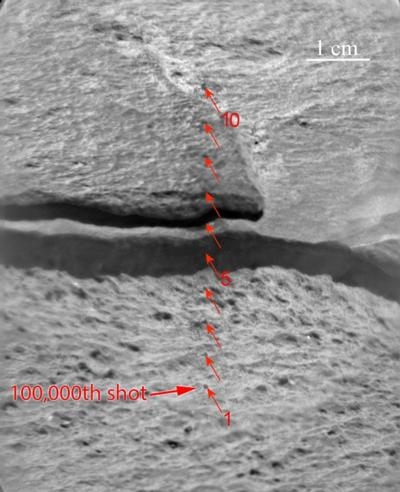Sun, Dec 15, 2013
Beam Checks Chemical Elements In Rocks And Soils
NASA's Curiosity Mars rover has passed the milestone of 100,000 shots fired by its laser. It uses the laser as one way to check which chemical elements are in rocks and soils. The 100,000th shot was one of a series of 300 to investigate 10 locations on a rock called "Ithaca" in late October, at a distance of 13 feet, 3 inches (4.04 meters) from the laser and telescope on rover's mast. The Chemistry and Camera instrument (ChemCam) uses the infrared laser to excite material in a pinhead-size spot on the target into a glowing, ionized gas, called plasma. ChemCam observes that spark with the telescope and analyzes the spectrum of light to identify elements in the target.

"Passing 100,000 laser shots is terribly exciting and is providing a remarkable set of chemical data for Mars," said ChemCam co-investigator Horton Newsom of the University of New Mexico, Albuquerque.
As of the start of December, ChemCam has fired its laser on Mars more than 102,000 times, at more than 420 rock or soil targets. Virtually every shot yields a spectrum of data returned to Earth. Most targets get zapped at several points with 30 laser pulses at each point. The instrument has also returned more than 1,600 images taken by its remote micro-imager camera.
An international team of scientists and students is mining information from ChemCam to document the diversity or materials on the surface inside Mars' Gale Crater and the geological processes that formed them. "These materials include dust, wind-blown soil, water-lain sediments derived from the crater rim, veins of sulfates and igneous rocks that may be ejecta from other parts of Mars," Newsom said.
Each pulse delivers more than a million watts of power for about five one-billionths of a second. The technique used by ChemCam, called laser-induced breakdown spectroscopy, has been used to assess composition of targets in other extreme environments, such as inside nuclear reactors and on the sea floor. Experimental applications have included environmental monitoring and cancer detection. NASA's Mars Science Laboratory Project, using the Curiosity rover, is the first mission to use it on another planet.
(NASA image)
More News
Aero Linx: JAARS Nearly 1.5 billion people, using more than 5,500 languages, do not have a full Bible in their first language. Many of these people live in the most remote parts of>[...]
'Airplane Bounced Twice On The Grass Runway, Resulting In The Nose Wheel Separating From The Airplane...' Analysis: The pilot reported, “upon touchdown, the plane jumped back>[...]
"Burt is best known to the public for his historic designs of SpaceShipOne, Voyager, and GlobalFlyer, but for EAA members and aviation aficionados, his unique concepts began more t>[...]
"Polaris Dawn, the first of the program’s three human spaceflight missions, is targeted to launch to orbit no earlier than summer 2024. During the five-day mission, the crew >[...]
There Are SO Many Ways To Get YOUR Aero-News! It’s been a while since we have reminded everyone about all the ways we offer your daily dose of aviation news on-the-go...so he>[...]
 ANN's Daily Aero-Linx (05.04.24)
ANN's Daily Aero-Linx (05.04.24) NTSB Final Report: Quest Aircraft Co Inc Kodiak 100
NTSB Final Report: Quest Aircraft Co Inc Kodiak 100 Aero-News: Quote of the Day (05.04.24)
Aero-News: Quote of the Day (05.04.24) Aero-News: Quote of the Day (05.05.24)
Aero-News: Quote of the Day (05.05.24) Read/Watch/Listen... ANN Does It All
Read/Watch/Listen... ANN Does It All



